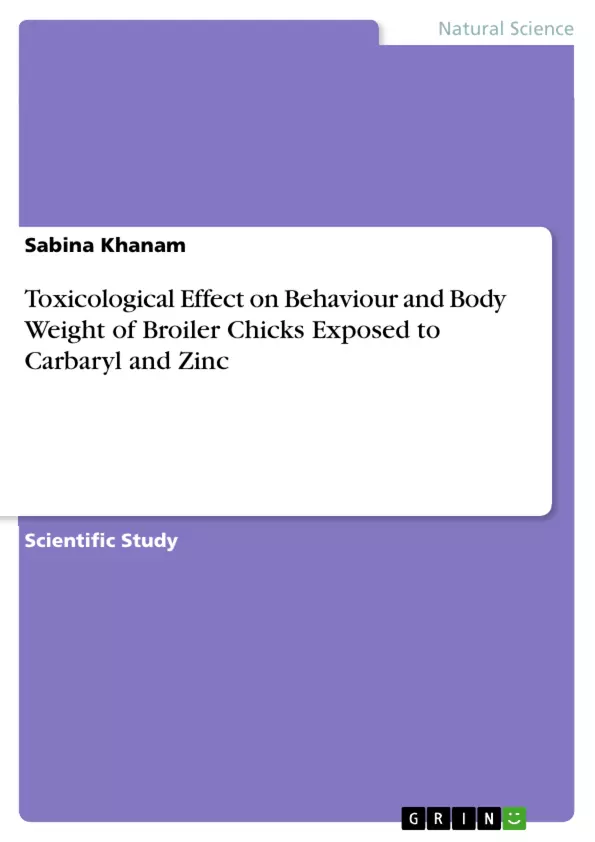This study was conducted to examine the effect of Carbaryl and Zinc on body weight and behaviour of broiler chicks. It deals with pesticides and heavy metals which are of great impotance for pest control in agriculture, various diseases in poultry and for growth in poultry simultaneously. Carbaryl, a carbamate insecticide, is used in poultry industry for destroying and preventing the pest and vectors for various animal diseases. Carbaryl inhibits the acetylcholinesterase (AChE) activity in vertebrates, insects and human beings while zinc is used in poultry industry for their growth and for normal functioning of different biochemical process in the body. If pesticide enter in the body in excess i.e., above the lethal dose than it can change the function of hormones, neurotransmitters, physiology, morphology and behaviour.
Statistically insignificant (p>0.005) increase in the body weight were found in the experimental animals as compared to control was recorded with different doses of carbaryl. While in zinc treated chickens statistically insignificant p>0.005 increases in the body weight of the experimental animals were found as compared to control were recorded with different doses of zinc.
Behavioural impacts were examined by looking at changes in activity patterns. Leg weakness ,frequent defecation, less food consumption and dizziness in broiler chicks were found given high dose of carbaryl after one week but the birds fed zinc showed an increase in behavior with increasing concentration up to a certain point, nervousness, leg weakness, and fluffed feathers were found in intermediate and high dose groups. On the other hand, relaxed, happy broiler chicks will vocalize frequently, eat hungrily, preen normally in control group.
Inhaltsverzeichnis (Table of Contents)
- Summary
- Chapter One
- Introduction
- Chapter Two
- Toxicological profile of carbaryl
- Toxicological profile of zinc
- Chapter Three
- Health effects of carbaryl
- Health effects of zinc
- Chapter Four
- Methodology
- Chapter Five
- Results and Discussion
- Effect of carbaryl on body weight
- Behavioural effects of carbaryl
- Effect of zinc on body weight
- Behavioural effects of zinc
- Results and Discussion
Zielsetzung und Themenschwerpunkte (Objectives and Key Themes)
This research study investigates the impact of carbaryl and zinc on the body weight and behavior of broiler chicks. The primary objective is to evaluate the toxicological effects of these substances, which are commonly used in the poultry industry. The study aims to determine the specific effects of carbaryl and zinc on the growth and well-being of these birds.
- Toxicological effects of carbaryl and zinc on broiler chicks
- Impact of carbaryl and zinc on body weight in broiler chicks
- Behavioral changes in broiler chicks exposed to carbaryl and zinc
- The role of carbaryl and zinc in the poultry industry
- Potential health risks associated with carbaryl and zinc exposure in poultry
Zusammenfassung der Kapitel (Chapter Summaries)
Chapter One provides a comprehensive introduction to the study, outlining the importance of pesticides and heavy metals in agriculture and poultry production. It highlights the role of carbaryl as a carbamate insecticide and zinc as a crucial element for poultry growth. The chapter also emphasizes the potential risks associated with excessive pesticide and heavy metal exposure in animals.
Chapter Two delves into the toxicological profiles of carbaryl and zinc. It explores the mechanisms of action of carbaryl as an inhibitor of acetylcholinesterase activity in vertebrates and insects, while outlining the essential role of zinc in various biochemical processes within the body.
Chapter Three focuses on the health effects of carbaryl and zinc, providing insights into their impact on the physiological and behavioral aspects of broiler chicks.
Chapter Four details the methodology employed in the study, describing the experimental design, sample size, and data collection methods.
Chapter Five presents the results and discussion of the study. It analyzes the effects of different doses of carbaryl and zinc on body weight and behavioral patterns in broiler chicks, highlighting the observed changes and their implications.
Schlüsselwörter (Keywords)
This research focuses on the toxicological effects of carbaryl and zinc on the body weight and behavior of broiler chicks. Key concepts include carbaryl, zinc, pesticides, heavy metals, poultry production, acetylcholinesterase inhibition, body weight changes, behavioral alterations, and toxicological assessment.
- Citar trabajo
- Sabina Khanam (Autor), 2017, Toxicological Effect on Behaviour and Body Weight of Broiler Chicks Exposed to Carbaryl and Zinc, Múnich, GRIN Verlag, https://www.grin.com/document/375851



